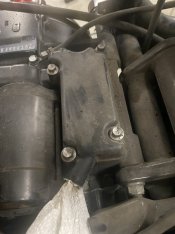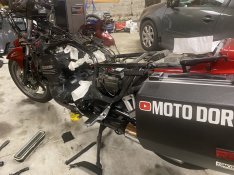I've begun the process of replacing this thing. However, as is with all repair jobs, one issue begets another. So, I figured as long as I'm replacing the radiator, might as well (as many suggested) replace all coolant hoses. And as long as I'm replacing those, might as well replace all o-rings related to coolant delivery. And of course might as well replace the thermostat and o-ring.
But to remove the coolant pipe on the rear of the engine, I have to remove the carbs. When I did that, I found them to be clean on the outside, but quite filthy inside. So, might as well clean and overhaul them. But I'm no carburetor whisperer. So, I'm sending them off Friday to Steve in sunny Florida for him to work his magic on them.
Upon removing the fuel tank, I found the petcock valve to be seeping fluid. So, that will also be replaced.
Once the carbs were out, I examined the air box. It was incredibly filthy. So I guess I will clean it out. Which brings me to a few questions for the group.
1. In one of the photos, you can clearly see a small box that would sit underneath the air box. What is this box? Do I need to open it and clean it out? What's inside it?
2. I've always wondered why there is a need to coat the air filter in oil. I don't do that with my car filter.
3. After removing the fuel tank, I have found there is a hairline crack in the right side, middle bottom. It is seeping gunk that is running down to where the underside of the fuel level float attaches. What is the best thing to use to seal this?
4. What are the odds I will get everything put back together perfectly?
But to remove the coolant pipe on the rear of the engine, I have to remove the carbs. When I did that, I found them to be clean on the outside, but quite filthy inside. So, might as well clean and overhaul them. But I'm no carburetor whisperer. So, I'm sending them off Friday to Steve in sunny Florida for him to work his magic on them.
Upon removing the fuel tank, I found the petcock valve to be seeping fluid. So, that will also be replaced.
Once the carbs were out, I examined the air box. It was incredibly filthy. So I guess I will clean it out. Which brings me to a few questions for the group.
1. In one of the photos, you can clearly see a small box that would sit underneath the air box. What is this box? Do I need to open it and clean it out? What's inside it?
2. I've always wondered why there is a need to coat the air filter in oil. I don't do that with my car filter.
3. After removing the fuel tank, I have found there is a hairline crack in the right side, middle bottom. It is seeping gunk that is running down to where the underside of the fuel level float attaches. What is the best thing to use to seal this?
4. What are the odds I will get everything put back together perfectly?



